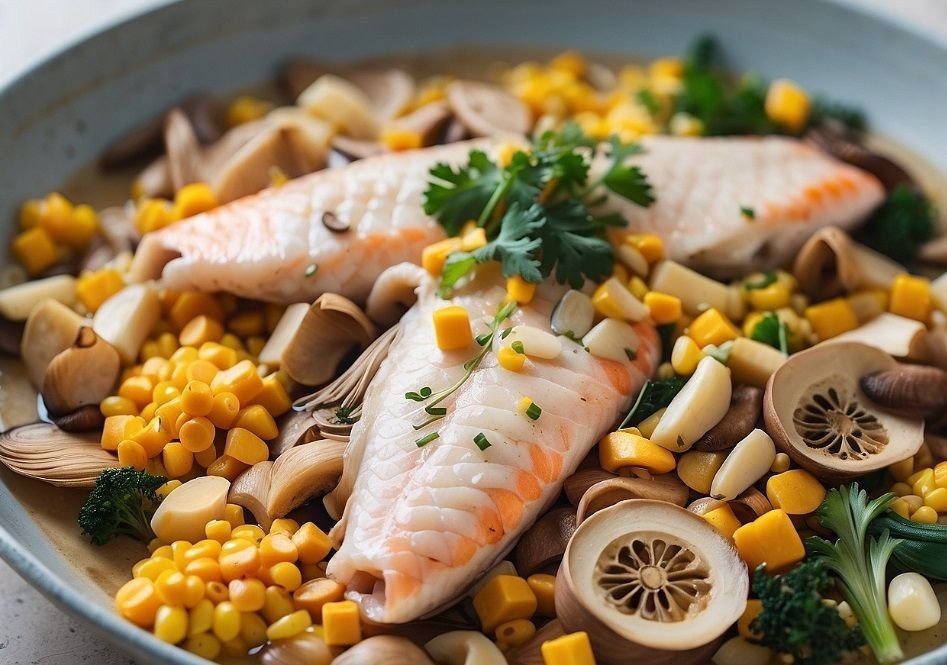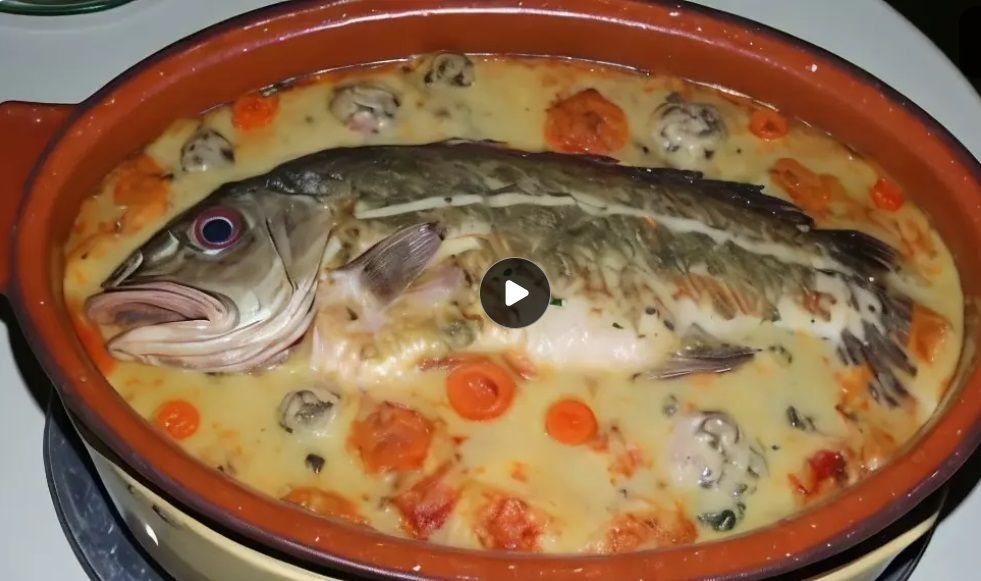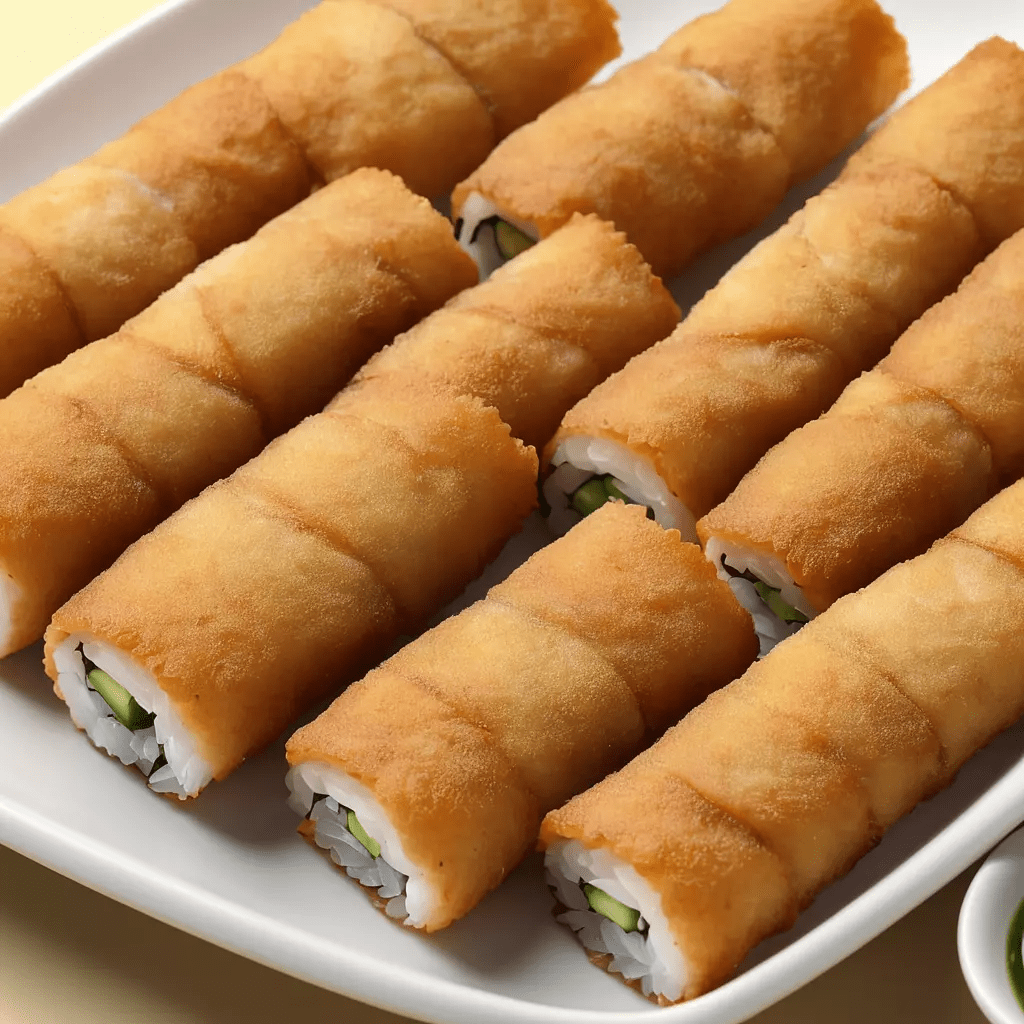Fish with straw mushrooms
Fish with straw mushrooms and miniature corn
Origin and Tradition: This delightful dish of fish with straw mushrooms and miniature corn originates from the culinary traditions of East China, particularly regions such as Zhejiang, Jiangsu, and Shanghai.
East China, with its abundant seafood and diverse agricultural produce, has a rich culinary heritage characterized by fresh flavors, subtle seasonings, and meticulous cooking techniques.
In traditional East Chinese cuisine, seafood, including fish, is highly prized for its freshness and delicate flavor. Straw mushrooms and miniature corn are commonly used vegetables in the region, known for their crisp texture and ability to absorb the flavors of other ingredients.
The combination of these ingredients reflects the region’s emphasis on balancing flavors and textures in dishes.
Ingredients:
- 500g white fish fillets (such as tilapia or sea bass), cut into bite-sized pieces
- 200g straw mushrooms, sliced
- 200g miniature corn, halved lengthwise
- 3 cloves garlic, minced
- 1 tablespoon ginger, minced
- 2 tablespoons soy sauce
- 1 tablespoon oyster sauce
- 1 tablespoon Shaoxing wine (or dry sherry)
- 1 tablespoon cornstarch
- 1 teaspoon sugar
- 1/2 teaspoon white pepper
- 2 tablespoons vegetable oil
- Salt to taste
- Chopped green onions for garnish
- Cooked rice, to serve
Instructions:
1. Marinate the Fish:
- In a bowl, combine the fish pieces with soy sauce, Shaoxing wine, cornstarch, sugar, and white pepper. Mix well to coat the fish evenly. Let it marinate for about 15-20 minutes.
2. Prepare the Sauce:
- In a small bowl, mix together soy sauce, oyster sauce, and a splash of water to create the sauce. Set aside.
3. Stir-Fry the Ingredients:
- Heat vegetable oil in a wok or large skillet over medium-high heat. Add minced garlic and ginger, and stir-fry for about 30 seconds until fragrant.
- Add the marinated fish pieces to the wok in a single layer. Cook for 1-2 minutes on each side until lightly browned and cooked through. Remove the fish from the wok and set aside.
- In the same wok, add a bit more oil if needed. Stir in the sliced straw mushrooms and halved miniature corn. Cook for 2-3 minutes until the vegetables are tender-crisp.
4. Combine and Finish:
- Return the cooked fish to the wok with the vegetables. Pour the prepared sauce over the fish and vegetables.
- Stir-fry everything together for another 1-2 minutes, ensuring that the sauce coats the fish and vegetables evenly and thickens slightly.
- Taste and adjust seasoning with salt or additional soy sauce if needed.
- Garnish with chopped green onions for freshness and color.
5. Serve:
- Transfer the stir-fried fish with straw mushrooms and miniature corn to a serving dish.
- Serve hot with steamed rice as a delicious and satisfying meal.
Enjoy your flavorful Chinese stir-fried fish with straw mushrooms and miniature corn, a delightful dish that combines tender fish with earthy mushrooms and crunchy corn for a delightful taste of East China cuisine.

Chinese Mushrooms: A Staple Ingredient in Chinese Cuisine
Chinese mushrooms, also known as Asian mushrooms or oriental mushrooms, are a fundamental element of Chinese culinary tradition. With their unique flavors, textures, and nutritional benefits, these vegetables play a crucial role in adding depth and complexity to a wide array of Chinese dishes. Let’s delve into the various types of these vegetables and their usage in Chinese cuisine.
1. Types :
Shiitake Mushrooms: Shiitake mushrooms are one of the most popular and widely used vegetable in Chinese cuisine. They have a meaty texture and a rich, earthy flavor that intensifies when cooked. Shiitake mushrooms are often used in stir-fries, soups, and braised dishes.
Wood Ear Mushrooms (Black Fungus): these vegetables are prized for their crunchy texture and mild, slightly sweet flavor. They are commonly used in salads, stir-fries, and soups, adding both texture and visual appeal to dishes.
Enoki Mushrooms: these ones have long, slender stems and small, delicate caps. They have a mild, slightly fruity flavor and a crisp texture. These vegetables are often used raw in salads or as a garnish for soups and stir-fries.
Oyster Mushrooms: these ones have a delicate, slightly sweet flavor and a tender texture. They are versatile mushrooms that can be used in a variety of dishes, including stir-fries, soups, and stews.
Cloud Ear Mushrooms: also known as tree ear mushrooms, have a unique crunchy texture and a mild flavor. They are commonly used in soups, stir-fries, and cold dishes.
2. Culinary Usage:
Stir-Fries: these vegetables are frequently used in stir-fried dishes, where their robust flavors and textures complement other ingredients such as meat, vegetables, and sauces. Shiitake mushrooms, in particular, are popular choices for stir-fries due to their meaty texture and umami-rich taste.
Soups and Stews: these vegetables add depth and complexity to soups and stews, infusing them with their distinctive flavors and aromas. Wood ear mushrooms and cloud ear mushrooms are commonly used in Chinese hot and sour soup, while shiitake mushrooms are often found in Chinese chicken and mushroom soup.
Braised Dishes: these vegetables are also commonly used in braised dishes, where they absorb the flavors of the braising liquid and become tender and flavorful. Oyster mushrooms are especially well-suited for braised dishes due to their tender texture and ability to hold up to long cooking times.
Dim Sum: these vegetables are frequently featured in dim sum dishes such as steamed dumplings and buns. Shiitake mushrooms are often used as a filling for vegetarian dumplings, while wood ear mushrooms are commonly found in vegetarian buns and rolls.
3. Nutritional Benefits:
These vegetables are not only delicious but also nutritious. They are low in calories and fat and rich in vitamins, minerals, and antioxidants. Shiitake mushrooms, for example, are a good source of B vitamins, copper, and selenium, while oyster mushrooms are high in protein and fiber.
Additionally, these vegetables contain compounds such as beta-glucans and polysaccharides, which have been shown to have immune-boosting and anti-inflammatory properties.
In conclusion, these vegetables are a versatile and nutritious ingredient that adds depth, flavor, and texture to a wide variety of Chinese dishes. Whether used in stir-fries, soups, braised dishes, or dim sum, these chinese vegetables are an essential element of Chinese cuisine, cherished for their unique flavors and culinary versatility.

Shaoxing wine and its usage in the East China cuisine
Shaoxing wine, also known as Shaoxing rice wine or simply Shaoxing, is a traditional Chinese rice wine originating from the city of Shaoxing in Zhejiang Province, East China. It holds a significant place in Chinese culinary culture and is widely used in both cooking and drinking. Here’s an overview of Shaoxing wine and its usage in East China cuisine:
1. Production and Characteristics:
- Shaoxing wine is made from fermented glutinous rice, water, and a small amount of wheat or barley. The fermentation process involves traditional methods, often using starter cultures containing various fungi and yeasts, resulting in a complex flavor profile.
- The wine is typically aged in ceramic jars or wooden barrels for a period ranging from a few months to several years, allowing the flavors to develop and mellow over time.
- Shaoxing wine ranges in color from pale yellow to deep amber, with a rich aroma and a slightly sweet, nutty flavor. It has an alcohol content of around 14-20%.
2. Culinary Usage:
- Shaoxing wine is a versatile ingredient in East China cuisine, prized for its ability to enhance the flavors of dishes while imparting a subtle sweetness and depth.
- It is commonly used as a seasoning in marinades, sauces, and braised dishes, where it adds complexity and richness to the flavor profile. For example, it is often added to marinades for meat or seafood to tenderize and add depth of flavor before cooking.
- Shaoxing wine is a key component of many traditional Chinese sauces, such as the famous “red-cooked” sauce used in braised dishes. It is also used in stir-fries to deglaze the pan and add flavor to the dish.
- In addition to savory dishes, Shaoxing wine is sometimes used in desserts and sweet dishes, particularly in combination with ingredients such as rock sugar or dried fruits to create rich, aromatic flavors.
3. Traditional Dishes:
- Shaoxing wine is an essential ingredient in numerous iconic East China dishes, including:
- Dongpo Pork (Braised Pork Belly): Shaoxing wine is a key component of the marinade and braising liquid, contributing to the dish’s rich, savory flavor.
- Drunken Chicken: This traditional dish involves marinating chicken in Shaoxing wine along with other seasonings, resulting in tender, flavorful meat.
- Lion’s Head Meatballs: Shaoxing wine is often added to the meatball mixture to enhance the flavor and aroma of the dish.
- Fish dishes: Shaoxing wine is frequently used in marinades and sauces for fish dishes, adding depth of flavor and removing any fishy odors.
4. Cultural Significance:
- Shaoxing wine holds cultural significance in Chinese culinary traditions and is often associated with celebrations, festivals, and family gatherings.
- It is also used in traditional Chinese medicine for its believed health benefits, such as promoting circulation, aiding digestion, and improving overall well-being.
- In Chinese folklore, Shaoxing wine is sometimes referred to as the “wine of poets and scholars,” reflecting its esteemed status in Chinese culture.
In summary, Shaoxing wine is an integral part of East China cuisine, where it is cherished for its rich flavor, versatility, and cultural significance. Whether used in marinades, sauces, or traditional dishes, Shaoxing wine adds depth and complexity to a wide variety of culinary creations, making it a beloved ingredient in Chinese cooking.

Chinese green onions and its usage in the chinese cuisine
Chinese green onions, also known as scallions or spring onions, are a fundamental ingredient in Chinese cuisine, valued for their fresh flavor, vibrant color, and aromatic qualities. They are widely used in various dishes, from stir-fries and soups to salads and dumplings. Here’s an overview of Chinese green onions and their usage in Chinese cuisine:
1. Characteristics:
- Chinese green onions have long, slender stalks with white bulbs at the base and green tops. Both the white and green parts are used in cooking, each contributing distinct flavors and textures to dishes.
- They have a mild onion flavor that is less pungent than regular onions, making them versatile for use in a wide range of dishes.
- Chinese green onions are available year-round and are relatively inexpensive, making them a staple ingredient in Chinese kitchens.
2. Culinary Usage:
- Chinese green onions can be used in both raw and cooked dishes, adding freshness, color, and flavor.
- They are commonly used as a garnish or finishing touch for soups, noodles, and stir-fries, providing a burst of flavor and visual appeal.
- In stir-fries, Chinese green onions are often added towards the end of cooking to preserve their texture and flavor. They can also be stir-fried briefly on their own as a simple side dish.
- Chinese green onions are frequently used to infuse oils and broths with their aroma and flavor. Sliced or crushed green onions are added to hot oil or broth and then strained out, leaving behind a subtle onion essence.
- They are a key ingredient in many Chinese sauces and marinades, such as the classic combination of soy sauce, rice vinegar, sugar, and chopped green onions used in dipping sauces for dumplings and noodles.
3. Traditional Dishes:
- Chinese green onions feature prominently in a variety of traditional Chinese dishes, including:
- Scallion Pancakes: Thin, crispy pancakes made from a simple dough of flour and water, filled with chopped green onions and pan-fried until golden brown.
- Congee: Chinese rice porridge flavored with ginger, chicken, or pork and garnished with chopped green onions for added freshness and aroma.
- Hot and Sour Soup: A tangy and spicy soup made with tofu, bamboo shoots, wood ear mushrooms, and green onions, among other ingredients.
- Steamed Fish with Ginger and Green Onions: Whole fish steamed with ginger, green onions, soy sauce, and sesame oil, resulting in a delicate and flavorful dish.
4. Health Benefits:
- Chinese green onions are not only delicious but also nutritious, containing vitamins, minerals, and antioxidants.
- They are rich in vitamin K, vitamin C, and folate, as well as antioxidants like quercetin and sulfur compounds that may have health-promoting properties.
- Additionally, green onions are low in calories and carbohydrates, making them a healthy choice for adding flavor and texture to dishes without adding excess calories.
In summary, Chinese green onions are a versatile and essential ingredient in Chinese cuisine, prized for their fresh flavor, vibrant color, and aromatic qualities. Whether used as a garnish, seasoning, or key ingredient in traditional dishes, green onions add depth and complexity to a wide variety of Chinese culinary creations.





